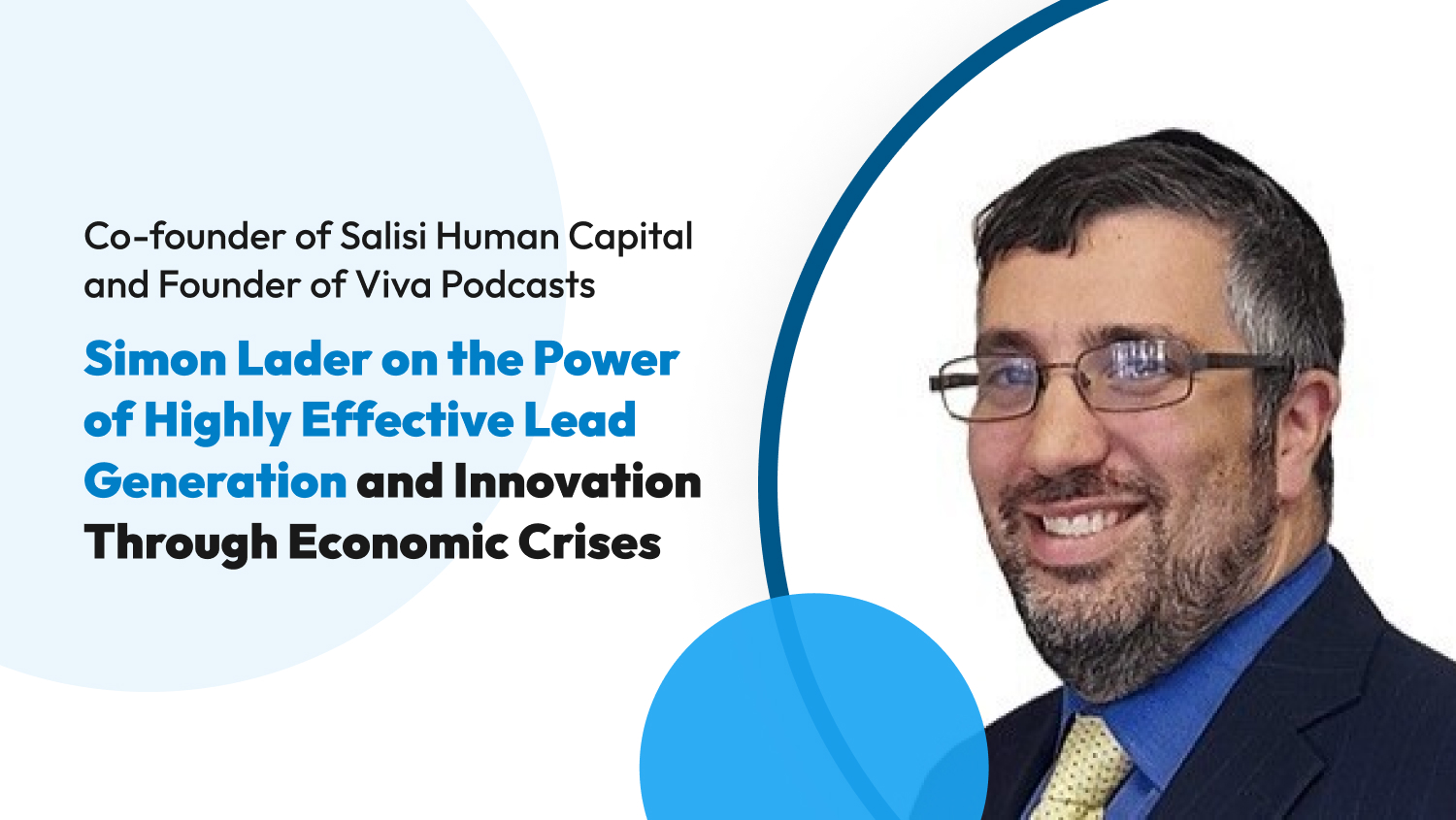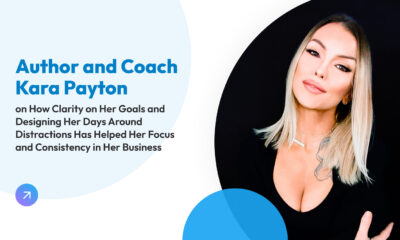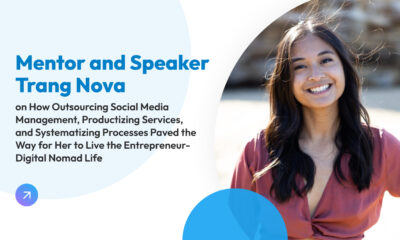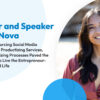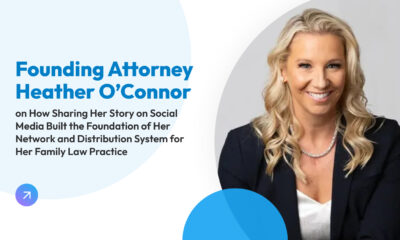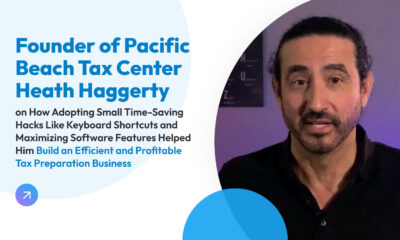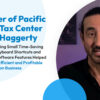Case Study
Co-founder of Salisi Human Capital and Founder of Viva Podcasts Simon Lader on the Power of Highly Effective Lead Generation and Innovation Through Economic Crises
After eight years as a recruitment consultant, Simon Lader co-founded the executive search firm Salisi Human Capital in 2005. They were then a boutique agency with a very niche market in the UK cybersecurity space, and the outlook was good. But what happens to a headhunting agency when a global crisis hits, and everyone stops hiring?
In this article, Lader talks about the ups and downs of Salisi’s last 18 years in the business. We look at the different challenges they faced and the systems and tools they used to overcome them. Don’t forget to check out Lader’s Productivity Stack Quick Reference and his Read-Watch-Listen list at the end of the article.
Table of Contents
- Starting
- Growing
- Scaling & Success
- Other Recommended Tools
- Hindsight: What Lader would have done earlier
- Advice from Lader: Betting on Several Horses
- Wrap-up
- Lader’s Read-Watch-Listen List
- Lader’s Productivity Stack Quick Reference
- More About Simon Lader
Starting
Challenge 1: Distribution: Finding qualified leads
From the outset, Salisi Human Capital sought to differentiate itself. Many other executive search firms work on a ‘no-win, no-fee’ basis, meaning they’re only paid when they facilitate a successful hire. But Lader says Salisi Human Capital offers quality-focused, client-driven services that need commitment from clients from the beginning of their relationship.
“Otherwise, we’ll find ourselves working on [filling a role], and the client has just gone and found candidates from somewhere else, which doesn’t serve them well, doesn’t serve us well. So right from the get-go, we needed to make it very clear how we were going to work.”
How did they find these types of clients who understood their value proposition?
Solution: Lader shares, “LinkedIn was then, and probably still is now our biggest tool.”
They used LinkedIn extensively for content marketing and to network. Even before it was popular, they made a point of regularly posting content. “There was no Canva. So we were using PowerPoint and then just taking screenshots and then dumping the screenshots into LinkedIn.”
And just like how one would network at an event, Lader and his co-founders used LinkedIn to make new connections. If there was a client they wanted to build a relationship with, they initiated connection requests that were friendly and casual instead of immediately pitching their offers.
Lader says, “Imagine that this room is full of potential clients. You don’t want to be the guy that walks up to someone who goes, ‘Hi, I’m Simon. Let me tell you all about what I can do for you…’, and barf them a whole bunch of information. No one wants to be that guy, and no one wants to listen to that guy!”
Lader and his co-founders not only treated LinkedIn outreach like any real-life social engagement, but they also used a “value-first strategy.” This meant they led with value offers, such as connecting a potential client with someone in their network or sending them a great article about their competitor. Only after two or three of these small favors do they ask anything or make a pitch.
Of course, they also needed to further pre-qualify these new leads to ensure they were the right fit. Back then, pre-qualification happened via email or LinkedIn messaging and sometimes on discovery calls.
People: Lader and other co-founders
Systems: Content marketing, outreach via LinkedIn, value-first strategy, pre-qualifying leads
Tools: LinkedIn, PowerPoint, whiteboard for project management
Challenge 2: How to sustain effective but time-intensive lead generation
The very personalized and client-focused lead generation process took a lot of time. They pre-selected companies that were part of their target market and did a lot of research to make connection requests that would stand out and leave a good impression. And by offering two to three value offers before making a pitch, this strategy was definitely high-effort and time-intensive.
For a new agency that needed to generate new business and deliver on commitments to clients, they needed additional support.
Solution: Lader shares, “When we were able to, we hired an administrator, and then the administrator was able to kind of take over some aspects of the lead generation. But I was still saying, ‘Okay, these are the 20, 30, 50 companies we want to go after. These are the titles of the people within those companies, go find those…’ And then giving very, very specific instructions. It was pretty time-consuming, but it needed to be done. Because the alternative was a very poor, generic message that was the same as everybody else’s.”
The administrator helped with lead generation and also took on some back-office tasks. Lader has always believed that one can be good at the business development side of things or the client delivery part of the business but very rarely excel in both. Hiring an administrator helped relieve some pressure on the client delivery side so Lader could focus more on his forte of bringing in new business.
People: Lader, other co-founders, administrator
Systems: Hiring additional staff
Tools: LinkedIn, whiteboard for project management
Growing
Challenge 3: Keeping pace between sales and delivery
As Salisi Human Capital grew, they faced a constant balancing act. They needed to ensure they were generating enough new business while simultaneously fulfilling client expectations on the service delivery side.
Lader emphasizes, “What you don’t want to do is to have your team selling stuff out of the capacity of your delivery team because you’re going to have disappointed clients. But at the same time, you don’t want your delivery team to be sitting there with nothing to do because the sales team hasn’t sold enough.”
This was a persistent challenge for Salisi as the business grew. From three co-founders in 2005, the agency expanded to over 20 staff by 2008. It was a period of rapid growth, and there was so much opportunity.
Solution: Over the years, Salisi has been able to define its priorities and a system to handle the balancing act. Lader shares, “Business development is paramount. The formula we kind of hit now is that we have enough people on our business development (biz dev) side who can jump in and help with client delivery if needed. So we always try to ensure that biz dev creates more work than the delivery team can do.”
Lader still believes business development and client delivery are two vastly different skill sets they’re not likely to find in one individual. But they have developed a level of competence with some business development team members so they can pitch in with the client delivery work when needed.
People: Lader, business development, and client delivery teams
Systems: Relief pitching system/using a flexible staffing model
Tools: Zoho, whiteboard for project management
Challenge 4: Global Financial Crisis of 2008
Salisi enjoyed impressive growth in the three years since it launched in 2005. Lader recalls, “Through the golden years of 2007 and early part of 2008, you just have to take a cap off and hold it out into the sunshine for money to fall into it. It was ridiculous the amount of money we were making.”
But as the US subprime mortgage crisis unfolded, things started to look bleak. During the week of the Lehman Brothers’ collapse in September of 2008, Salisi lost all its active projects. The financial crisis led to a global recession that froze any hiring activity, even for Salisi’s UK market.
Solution: In the face of the sharp turn in events, Salisi had little room to adjust. Lader counts themselves lucky they did not have to initiate lay-offs. Many of the team voluntarily took their redundancy packages as it was clear that the business was in a difficult situation. From a team of 25, Salisi shrank to a skeleton crew of five.
People: Lader, business development, and client delivery teams
Systems: Right-sizing of agency
Tools: Redundancy packages
Scaling & Success
Challenge 5: Pandemic and lockdowns of 2020
Salisi started rebuilding in 2010 and by 2012, had expanded to international operations. Lader relocated to Las Vegas to set up their US office. They had established a good reputation in the industry and had a loyal client base.
But just a few years later, another crisis struck – the COVID pandemic led to a freeze in hiring in the cybersecurity industry again. They couldn’t just sit back and rely on their loyal client base to bring them business; they needed a way to find new clients and stay relevant while waiting for businesses to reopen and bounce back.
Solution: Lader jumped at the opportunity to learn new marketing approaches. He recounts, “I put myself through social media and social marketing school. I entered the world of ClickFunnels. We started building a funnel, we started an email list – all of which we had not heard of before because we didn’t need them.”
As he immersed himself in the world of online marketing, Lader also began networking outside of his usual circles. Eventually, he met someone at a mastermind group who invited him to guest on a podcast. This started him on a podcast guesting circuit where he could promote Salisi. He jokes, “The accent goes a long way. The fact that I’m British, I live in Vegas, the whole kind of reinvention of who we were, what we’re doing — that seemed to be quite interesting for people at the time.”
His frequent podcast guesting opened another opportunity for Salisi. Lader continuously got feedback that he should start his own podcast.
People: Lader, mastermind contact, network
Systems: Networking, learning new skills to stay relevant
Tools: LinkedIn, Facebook groups, ClickFunnels
Challenge 6: Hitting the right note on the podcast
Taking his cue from all the encouragement to launch his own podcast, Lader decided to go for it. With all the business uncertainty due to the pandemic, Lader knew hiring would be the last of their clients’ priorities. So the initial idea was to create a podcast to help Salisi engage with and stay relevant to its market during this period.
Lader prepared by doing plenty of research. He tells us, “The thing that came up over and over again was podcast about what you know. So I thought, ‘Okay, well, I’ve been in headhunting for almost 22 years. I’ll just podcast about that.’ What possibly could go wrong?”
All fired up, Lader recorded five or six episodes about headhunting in two days. When he reviewed the recordings, his reaction was, “They were awful. They were boring. I kind of went away with my tail between my legs, and I thought, ‘Okay, podcasting as a host clearly isn’t for me.’ Because I mean, I wouldn’t even listen to it, and I’m the one who made the thing!”
Solution: He carried on guesting on podcasts and got some encouragement from his mastermind contact, who first introduced him to podcasting. He went back to the drawing board, researched again, read more, and talked to more people. Then he finally had his ‘aha moment’:
“The thing that is much more important when deciding what to podcast about is it’s something about which you are intellectually curious. And this goes for writing blogs, LinkedIn or Facebook lives, and anything like that. If you have intellectual curiosity, you’re far more likely to be passionate. And it’s that passion that will fuel you to do it week after week, month after month. Because without consistency, a podcast is dead in the water. But also, that will be the contagion that will attract other people and make it go viral so that people will share it.”
Lader decided to focus the podcast, which he called “The Conference Room,” on experts on business growth. His guests ranged from high-level executives who could speak about the cradle-to-grave of business growth to niche experts like individuals with extensive experience in email marketing.
People: Lader, mastermind contact, network
Systems: Networking, research through reading and conversations with others in the podcasting field
Tools: LinkedIn, Facebook groups, podcasting tools
Challenge 7: Monetizing the podcast
The Conference Room podcast debuted in December 2020 and, by the first quarter of 2023, had reached the top 0.5% of podcasts globally in terms of listeners per month. Aside from using the podcast to stay connected with their market, Lader knew they could capitalize on this to generate revenue for Salisi.
But turning a podcast into a revenue-generating vehicle via sponsorships or advertisements turned out to be very tough. Lader explains, “For example, currently, Spotify is paying approximately 14 cents per 100 listens. So if you get a thousand people listening to your podcast, that’s going to be $1.40. Unless you are Joe Rogan or you’ve got an enormous campaign behind you, then just using advertising and sponsorship is not going to get you much money.”
Solution: Lader and his team figured out how to use the podcast as a lead generation tool. Based on their thorough knowledge of their target market, of what they need, and how Salisi could serve them, they structured the podcasts to become their sales funnel. Lader says, “The lead flow pretty much qualifies itself out. So when they’re actually on a call and speaking to myself or my colleagues, a lot of the hard work’s already been done.”
The Conference Room podcast brought in six figures of revenue in 2022 from lead generation, and it was around this time that Lader decided to launch a separate company, Viva Podcasts. Through Viva Podcasts, Lader will coach individuals or businesses on generating revenue from podcasts without relying on advertisements and sponsorships.
People: Lader, Salisi co-founders
Systems: Creating a sales funnel through podcasting
Tools: LinkedIn, Facebook groups, podcasting tools
Other Recommended Tools
Lader is very mindful of his limited work hours and firmly believes “I should only be doing the things that I’m uniquely qualified to do. Everything else I either delegate, I outsource, or I automate.” He shared a few other tools the team behind Salisi uses that help with this issue:
- Zapier for automation of workflows
- Trello for project management
- Microsoft 365 tools like email, calendar, planner
- Zoom for video conferencing
- Calendly for appointment setting
They used Slack for some time but found it to be more of a distraction.
Hindsight: What Lader would have done earlier
Lader thinks implementing changes before the economic crisis of 2008 and 2020 would have helped the business recover and grow much faster. For example, Salisi could have seen amazing growth much sooner if they had launched the podcast before the lockdowns.
But Lader acknowledges, “At the end of the day, you can only play the cards you’ve been dealt. So situations come along, you react to them, you learn what you need to do, you have a process of elimination, and you implement. If I could have done it sooner, I would have done it. But you don’t know what you don’t know, do you?”
Advice from Lader: Betting on Several Horses
Lader credits Salisi’s ability to recover and reinvent the business after several major crises to their approach to problem-solving and innovating.
“I think what served us well has been the fact that we haven’t just picked one horse. We backed five or six. And two or three furlongs into the race, when we see there are two or three emerging as the winners, then we’re pushing all our money behind those. And then a furlong or two later, one is emerging as the clear leader, that’s where all our attention is going.”
They do not test solutions one at a time. They simultaneously roll out different strategies and work equally hard on all of them since they don’t know which one will succeed. This means the team has to find the capacity to support several initiatives implemented in parallel instead of just one. As they see the results, they then double down on what emerges as the best solution.
The most recent example of this was their search for a lead magnet during the pandemic. Salisi launched a blog together with the podcast. When the podcast began to gain traction, they focused their resources and efforts there.
Wrap up
Salisi Human Capital successfully navigated two global economic downturns and came out stronger and better each time. They know their market well, where and how to find them, serve them well, and build great relationships.
But another factor that has made them very resilient is their willingness to start over, learn and try new ideas. After the Global Financial Crisis of 2008, they ventured out to the US to establish international operations. During the COVID lockdowns, they pivoted to social media and email marketing, blogging, and podcasting. Each crisis was taken as an opportunity to test new strategies and reinvent themselves.
Under Lader’s leadership, Salisi’s latest venture has been to diversify from pure headhunting services. Viva Podcasts will launch in November and will offer coaching, consulting, and production services to the podcasting community. We look forward to seeing their blueprint for leveraging podcasts for marketing and lead generation.
Lader’s Read-Watch-Listen List
- $100M Offers: How To Make Offers So Good People Feel Stupid for Saying No by Alex Hormozi
- Austin Armstrong
- Neil Patel
- Social Media Examiner by Michael Stelzner
- One Million Followers by Brendan Kane
- Dotcom Secrets, Expert Secrets, and Traffic Secrets by Russell Brunson
- One Funnel Away Challenge
Lader’s Productivity Stack Quick Reference
Starting Stack
Growing Stack
- Zoho
- Redundancy packages
- Facebook groups
Scaling & Success Stack
More About Simon Lader
Simon Lader helps business owners and podcasters make money from podcasting. If you are a business owner looking for high-quality leads or sales, or a podcaster looking to grow your audience and your earnings, Simon, and his company Viva Podcasts, can help you. He grew his own podcast “The Conference Room” from zero to the top 0.5% of all podcasts within two years, earning six figures from it in its second year, and now helps podcasters, entrepreneurs, and business owners – with and without podcasts – unleash the power of podcasting to grow their revenues and earnings.
He has an incredible guide ‘Podcast Powerups’ where he features some of his best money-making and audience-building strategies that you can put into practice and see the impact right away, and it’s available here: https://www.vivapodcasts.com/podcastpowerups
If you want to connect with Simon, the best place is in his free Facebook Group: www.facebook.com/groups/scalesharemonetize, which is packed full of actionable tips and strategies he uses with his Viva Podcasts clients to grow their shows and their earnings.


